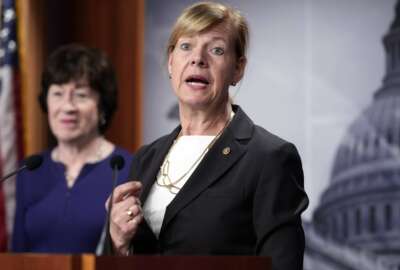Hubbard Radio Washington DC, LLC. All rights reserved. This website is not intended for users located within the European Economic Area.
On Air: Federal News Network
Trending:
Federal pros rise to social media challenges
The federal government is no stranger to Facebook, Twitter, blogs and even photo-sharing sites like Flickr. Using those tools effectively is the subject of the ...
wfedstaff | June 3, 2015 8:22 pm
By Suzanne Kubota
Senior Internet Editor
FederalNewsRadio.com
The federal government is no stranger to Facebook, Twitter, blogs and even photo-sharing sites like Flickr. More and more, agencies are using social media to get the word out and connect with citizens. But making sure those messages are effective takes skill. Using those tools effectively is the subject of the Federal News Radio Discussion: Shouting from the Rooftops.
Joining us for the discussion are:
- Jennifer Gustetic, lead associate at Phase One Consulting Group.
- Sheila Campbell, director of the GSA Center for Customer Service Excellence and Acting Director of the GSA Center for New Media and Citizen Engagement.
- Haley Van Dyck, the Federal Communications Commission New Media Director of Citizen Engagement
Here are some of the topics, questions and excerpts from the responses of the panel:
Part 1: Getting to Know You
Gustetic said she’s been working with agencies since Open Government directive “focusing more on open government as a whole and innovation tactics” for agencies like Transportation and HUD. Her focus, she said, has been less on the new media side and “more engaged in the high level planning piece of a lot of how to get the agencies to a more transparent, participatory and collaborate state, and so part of that involves the use of social media but it’s a lot bigger than that.” Her work has been to set up infrastructure, like the nuts and bolts and policies and procedures.
GSA, said Campbell, is “doing a number of things to help agencies achieve their mission through social media.” One of the first things her office was asked to do was to help agencies come up with online dialogue tools so that the public could comment on Open Government plans. Instead of 24 different agencies developing their own tools, “it made so much more sense to find a common tools.” As a result, the federal government realized a “huge cost savings” “the out of pocket expense for that was $10,000” and it would have cost a lot more otherwise. so that’s an example of what gsa has done to help agencies find common solutions to their social media challenges.
Where GSA is going wide, Van Dyck said the FCC is going deep; especially in terms of a bench. In setting up the first new media dept at FCC, they have the largest new media team in the federal government. The work covers “not just communications, but do a lot of work focused on citizen engagement and participation, as well as data and transparency.” At the same time, the office is redesigning FCC.gov, “affectionaly referred to as probably the worst website in the federal government. So it’s a big challenge for us right now.” Her team has been working on it for five months with 1.6 million pages on the site now. They’re expecting a March launch of the redesign. She describes FCC’s social media effort as “very much up and running” on over a dozen different sites, “and we like to brag about the third largest Twitter following in the federal government.”
Campbell found that the biggest challenge of the job is overcoming cultural barriers and the notion that putting data online somehow puts the agency at risk. “Over a long long time, agencies have developed cultures where it’s low risk, they resistant to change, or resistant to looking at opportunities to use these emerging technologies.” Another barrier Campbell said is the other side of the coin. “I think the biggest mindset barrier that we have to overcome is people using the tools for the sake of using the tools.” In order to make a business case to use social media within their agencies, Campbell advises “don’t go into your supervisor’s office and say ‘Hey! We need a Facebook page’ or ‘Hey, we need to have a channel on YouTube.’ It’s what’s the business problem that you’re trying to solve.” Figure out who is your audience and where they are on the web.
Gustetic agreed, saying these are just new tactics to drive performance. Ultimately, social media, prizes and competitions are new tactics for driving performance. “If they’re not driving performance, then why are you using them.”
Part 2: New Here!
In the second part of the Federal News Radio Discussion, Van Dyck talks about how social media serves the FCC’s needs, pointing out the FCC is “in the communications business” but part of that is to listen to the public. New media, she said “is a way of making us more efficient at our jobs.”
She also described moving from the Obama campaign to the FCC as “a very fun experience,” learning how to take engagement and translating that into better governance.
Part 3: Finding the Path to Transparency
The topic for part three included the relative importance of datasets and blogs in transparency.
Gustetic outlined “four high level steps we think are really important in transparency”:
- Cataloging and inventory of data – “Most departments, surprise surprise, don’t even know what data they have.”
- Create a data release policy around that – “How do you release them.”
- Security scrub – Make sure that the data you release, when combined with other data, doesn’t compromise security.
- Visualizing and contextualizing – “So you can use it to drive decision making and agency accountability.”
Campbell talked a bit about a new website GSA is working on called howto.gov “to provide agencies with real practical step by step guidance in terms of how do you do a blog.” The most important thing, said Campbell, is for blogs to be “authentic.” Current government blogs, said Campbell, are still being written in a very formal tone. “They’re really losing the point and the purpose of the blog,” said Campbell, which is to share and interact with the users. Some notable exceptions, she said, include some TSA and GSA blogs.
Van Dyck said being inclusive shouldn’t apply only to the audience of the blog. There’s room for opposing viewpoints from inside the FCC, she said. As an example, Van Dyck said there were more than 50 people blogging on the National Broadband Plan site. It gave the agency the chance to ask question of the public, “and really encourage debate and conversation. So it’s not just a messaging tool. It’s very much a conversational tool as well.”
Part 4: The Business Case and Justin Bieber
How to make a business case for the costs associated with the move to use more new media and how you might be able to tell it’s paying off.
Campbell said making the cost of using social media more effective is GSA’s bread and butter. Instead of agencies, individually, “going out there buying their own infrastructure, seeking out their own tools, doing all the market research, we can do that centrally.” But, she cautioned, there still are costs. Through howto.gov, Campbell said GSA is helping agencies think through a plan to use and maintain the tools, and “not just launch and leave.”
The FCC, said Van Dyck is “running into incredible cost savings” by using more webservices that are more dynamic and create “more agile, better results.” Users on the other side of the servers have noticed too. Van Dyck said the FCC now has more than 380,000 followers on Twitter. Modestly, she said, “we might benefit a little bit from having strong faith in technology followers.” She admitted she didn’t know how those numbers compare to the number of Justin Bieber’s followers, but did say the agency trails the White House, “who gets to Tweet about Obama,” and the CDC “which gets to Tweet about health crisises.”
Part 5: Surprises Along the Way
The hour wrapped up with the Federal Drive team asking the panel about surprises they’ve run into in their jobs using new and social media.
“Right off the bat,” said Van Dyck, “I struggled a bit and shocked about how siloed the agency really was and how much duplication there was of efforts across the agency.” Van Dyck said a “really fun part of the job,” her first in federal government, “is integrating all that and bringing everybody onto the same team and working towards a common goal of one voice for the FCC.”
Campbell noted that so much effort has been focused on datasets, to this point, that communication is lacking. “I think the greatest thing we can do to improve transparency in government is actually to change the way we communicate – is to communicate in plain language.” Especially, she said, with mobile devices “we have to learn to write content concisely so that people can get a quick answer to their question on a small screen.”
Finally, Gustetic said she’s surprised more has not been made about how Open Gov fits into the larger innovation agenda. She said she believes the discussion needs to start at the agency level, but rise quickly to include OMB and Congress, “so that when we’re putting these things in budgets, and we’re talking about doing these things to further mission performance, that they’re not getting cut because they look like fat. Because they’re not fat. They help to drive mission performance, but that discussion is not happening at all the levels that it needs to be happening at right now.”
Copyright © 2024 Federal News Network. All rights reserved. This website is not intended for users located within the European Economic Area.
-
Don’t look now, but your TSP is swooning Federal Drive
-
DoD gets serious about technology transfer to the troops Federal Drive




